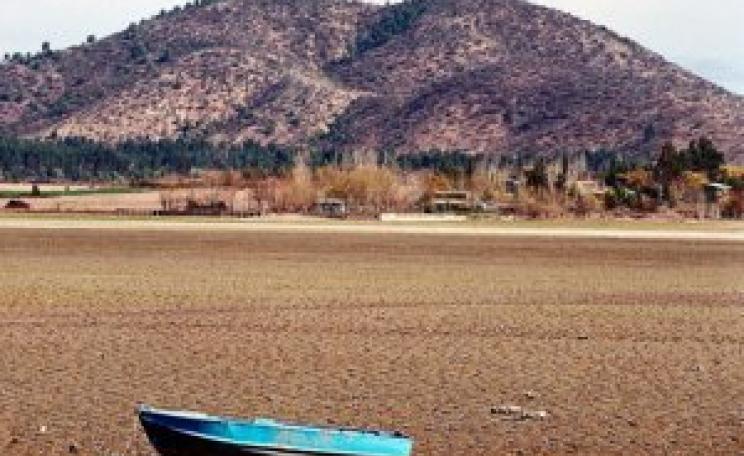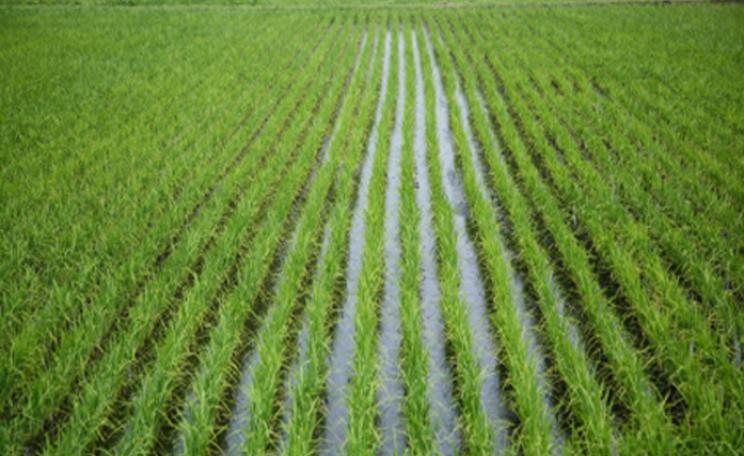Prior to 1950, growth of the food supply came almost entirely from expanding cropland area. Then as frontiers disappeared and population growth accelerated after World War II, the focus quickly shifted to raising land productivity. In the most spectacular achievement in world agricultural history, farmers doubled the grain harvest between 1950 and 1973. Stated otherwise, growth in the grain harvest during this 23-year-span matched that of the preceding 11,000 years.
This was the golden age of world agriculture. Since then, growth in world food output has been gradually losing momentum as the backlog of unused agricultural technology dwindles, as soil erodes, as the area of cultivable land shrinks, and as irrigation water becomes scarce.
With water shortages constraining food production growth, the world needs a campaign to raise water productivity similar to the one that nearly tripled land productivity over the last half-century. Data on the efficiency of surface water projects-that is, dams that deliver water to farmers through a network of canals-show that crops never use all the irrigation water simply because some evaporates, some percolates downward, and some runs off. Water policy analysts Sandra Postel and Amy Vickers found that ‘surface water irrigation efficiency ranges between 25 and 40 percent in India, Mexico, Pakistan, the Philippines, and Thailand; between 40 and 45 percent in Malaysia and Morocco; and between 50 and 60 percent in Israel, Japan, and Taiwan.'
China's irrigation plan is to raise efficiency from 43 percent in 2000 to 55 percent in 2020. Key measures include raising the price of water, providing incentives for adopting more irrigation-efficient technologies, and developing the local institutions to manage this process. Raising irrigation efficiency typically means shifting from the less-efficient flood or furrow systems to over- head sprinklers or to drip irrigation, the gold standard of irrigation efficiency. Switching from flood or furrow to low-pressure sprinkler systems reduces water use by an estimated 30 percent, while switching to drip irrigation typically cuts water use in half.
Drip irrigation
Drip irrigation also raises yields because it provides a steady supply of water with minimal losses to evaporation. In addition, it reduces the energy needed to pump water. Since drip systems are both labor-intensive and water-efficient, they are well suited to countries with a surplus of labor and a shortage of water. A few small countries-Cyprus, Israel, and Jordan-rely heavily on drip irrigation. This more-efficient technology is used on 1-3 percent of irrigated land in India and China and on roughly 4 percent in the United States.
In recent years, small-scale drip-irrigation systems- literally an elevated bucket with flexible plastic tubing to distribute the water-have been developed to irrigate small vegetable gardens with roughly 100 plants (covering 25 square meters). Somewhat larger systems using drums irrigate 125 square meters. In both cases, the containers are elevated slightly so that gravity distributes the water. Large-scale drip systems using plastic lines that can be moved easily are also becoming popular. These simple systems can pay for themselves in one year. By simultaneously reducing water costs and raising yields, they can dramatically raise incomes of smallholders. Sandra Postel of the Global Water Policy Project estimates that drip technology has the potential to profitably irrigate 10 million hectares of India's cropland, nearly one tenth of the total. She sees a similar potential for China, which is now also expanding its drip irrigated area to save scarce water.
Local organising
Institutional shifts-specifically, moving the responsibility for managing irrigation systems from government agencies to local water users associations-can facilitate the more efficient use of water. Farmers in many countries are organizing locally so they can assume this responsibility, and since they have an economic stake in good water management they tend to do a better job than a distant government agency. Mexico is a leader in developing water users associations. As of 2008, farmers associations managed more than 99 percent of the irrigated area held in public irrigation districts. One advantage of this shift is that the cost of maintaining the irrigation system is assumed locally, reducing the drain on the treasury.
Low water productivity is often the result of low water prices. In many countries, subsidies lead to irrationally low water prices, creating the impression that water is abundant when in fact it is scarce. As water becomes scarce, it needs to be priced accordingly. A new mindset is needed, a new way of thinking about water use. For example, shifting to more water- efficient crops wherever possible boosts water productivity. Rice growing is being phased out around Beijing because rice is such a thirsty crop. Similarly, Egypt restricts rice production in favor of wheat. Any measures that raise crop yields on irrigated land also raise irrigation water productivity.
Bringing water use down to the sustainable yield of aquifers and rivers worldwide involves a wide range of measures not only in agriculture but throughout the economy. The more obvious steps, in addition to adopting more water-efficient irrigation practices, include using more water-efficient industrial processes. Recycling urban water supplies is another obvious step in countries facing acute water shortages. And because coal-fired power plants use so much water for cooling, shifting to wind farms eliminates a major drain on water supplies. Another way to raise both land and water productivity is to produce animal protein more efficiently. With some 35 percent of the world grain harvest (760 million tons) used to produce animal protein, even a modest reduction in meat consumption or gain in efficiency can save a large quantity of grain.
Joined-up thinking
Ensuring future food security was once the exclusive responsibility of the ministry of agriculture, but this is changing. Saving the mountain glaciers whose ice melt irrigates much of the cropland in China and India during the dry season is the responsibility of the ministry of energy, not solely the ministry of agriculture. If the ministries of forestry and agriculture cannot work together to restore tree cover and reduce floods and soil erosion, grain harvests will shrink not only in smaller countries like Haiti and Mongolia, as they are doing, but also in larger countries, such as Russia and Argentina-both wheat exporters.
And where water shortages restrict food output, it will be up to ministries of water resources to do everything possible to raise national water productivity. With water, as with energy, the principal potential now is in increasing efficiency, not expanding supply. In a world where cropland is scarce and becoming more so, decisions made in ministries of transportation on whether to develop land-consuming, auto-centered transport systems or more-diversified systems that are much less land-intensive will directly affect world food security. In the end, it is up to ministries of finance to reallocate resources in a way that recognizes the new threats to security posed by agriculture's deteriorating natural support systems, continuing population growth, human- driven climate change, and spreading water shortages. Since many ministries of government are involved, it is the head of state who must redefine security.
At the international level, we need to address the threat posed by growing climate volatility and the associated rise in food price volatility. The tripling of wheat, rice, corn, and soybean prices between 2007 and 2008 put enormous stresses on governments and low-income consumers. This price volatility also affects producers, since price uncertainty discourages investment by farmers. In this unstable situation, a new mechanism to stabilize world grain prices is needed-in effect, a World Food Bank (WFB). This body would establish a support price and a ceiling price for wheat, rice, and corn. The WFB would buy grain when prices fell to the support level and return it to the market when prices reached the ceiling level, thus moderating price fluctuations in a way that would benefit both consumers and producers. The principal role of the WFB governing board, representing major exporting as well as importing countries, would be to establish the price levels for acquiring and releasing grain.
One simple way to improve food security is for the United States to eliminate the fuel ethanol subsidy and abolish the mandates that are driving the conversion of grain into fuel. This would help stabilize grain prices and buy some time in which to reverse the environmental and demographic trends that are undermining our future. It would also help relax the political tensions over food security that have emerged within importing countries. And finally, we all have a role to play as individuals. Whether we decide to bike, bus, or drive to work will affect carbon emissions, climate change, and food security. The size of the car we drive to the supermarket and its effect on climate may indirectly affect the size of the bill at the supermarket checkout counter. At the family level, we need to hold the line at two children. And if we are living high on the food chain, we can eat less grain-intensive livestock products, improving our health while helping to stabilize climate. Food security is something in which we all have a stake-and a responsibility.
This is an extract from Lester Brown's World on the Edge: How to Prevent Environmental and Economic Collapse (Earthscan,2011)
READER OFFER: For a 20 per cent discount enter code AF20 in the voucher box when you order online at Earthscan
| READ MORE... | |
 |
NEWS ANALYSIS Aral Sea - a cause for hope? Does the Aral Sea, the biggest environmental disaster of the 90s, offer us cause for hope? Paul Miles reports, and sees parallels with a bigger man-made disaster – climate change |
 |
NEWS Ancient tradition of water purification could save lives Thousand-year-old Indian method of using tree seeds to purify water should be used more widely for tackling waterborne diseases |
 |
INTERVIEW Joyce D'Silva: 'Meat should carry a health warning' Eifion Rees talks to the Compassion in World Farming veteran and co-editor of The Meat Crisis - a shocking new book that exposes the range of environmental and health threats facing us if we don't kick our addiction to meat |
 |
NEWS Human waste could be fertiliser and power source Many of the substances that make wastewater a pollutant can also be useful as fertilisers for agriculture and in generating gases for small power stations, says report |
 |
COMMENT The water footprint: the hidden cost of our meat consumption Watching our leaky taps is the least of our problems when it comes to water wastage - agricultural practices and animal products are by far the greater danger |





